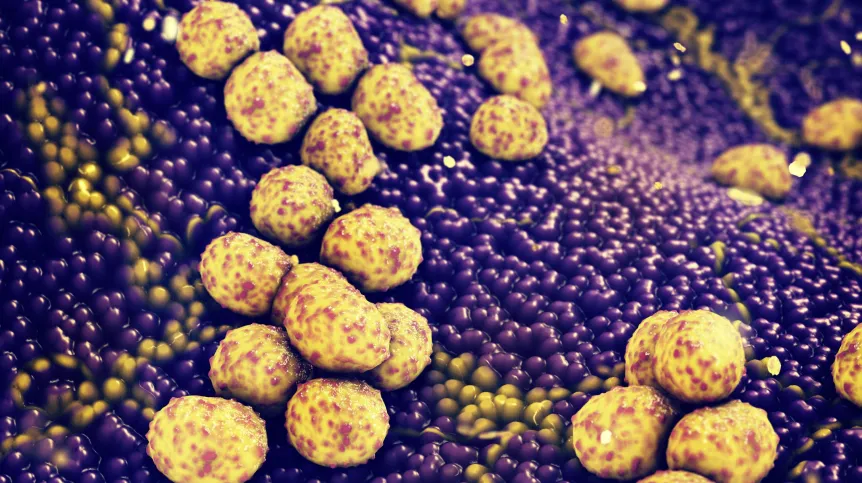
Polish scientists have taken a step forward in the fight against one of the most stubborn and dangerous bacteria: Staphylococcus aureus.
The notorious pathogen is behind a range of infections, from annoying skin conditions like acne to life-threatening diseases such as pneumonia and heart infections.
What makes S. aureus especially troublesome is its ability to quickly develop resistance to antibiotics, leaving doctors with fewer treatment options. But now, research from the Institute of Biochemistry and Biophysics of the Polish Academy of Sciences suggests a new weapon in the fight—bacteriophages and bacteriocins.
The Rise of the Superbug
Staphylococcus aureus is a common bacteria found on the skin and in the nose of many healthy people. But when it invades deeper into the body, it can cause severe infections. Even more troubling, S. aureus is a master at acquiring resistance to antibiotics, making infections harder to treat. In fact, strains like methicillin-resistant Staphylococcus aureus (MRSA) have become infamous for their resistance to common antibiotics, posing a serious public health challenge worldwide.
The Polish research team, led by Dr. Małgorzata Łobocka, has now found a way to fight back. By harnessing the power of bacteriophages (viruses that infect only bacteria) and bacteriocins (small, protein-based molecules produced by certain bacteria to kill other bacteria), they’ve developed new strategies to tackle S. aureus, including its antibiotic-resistant forms.
Bacteriophages: A Virus That Destroys S. aureus
Dr. Łobocka and her team have been working on bacteriophages for years, carefully selecting viruses that specifically target S. aureus and refining them into highly effective treatments. In lab tests, their bacteriophage preparations successfully wiped out up to 90% of drug-resistant S. aureus strains. What makes this even more promising is that these bacteriophages don’t harm the beneficial bacteria that live in our bodies—an important advantage over traditional antibiotics, which can destroy our gut microbiome and lead to other health issues.
One of the key breakthroughs of the research is the development of genetically pure, consistent bacteriophage preparations that could potentially treat a wide variety of S. aureus infections, including skin conditions like acne.
“We can create a bacteriophage preparation tailored to each strain of S. aureus,” Dr. Łobocka explains. This means that treatments could be customized for specific infections, offering more targeted and effective results.
The team’s work has already shown promising results in experimental models, where nematodes infected with S. aureus survived after being treated with the bacteriophage preparations. These results suggest that bacteriophages could be a game-changer for treating stubborn infections in humans too.
Bacteriocins: Tiny Proteins with Big Potential
In addition to bacteriophages, another promising tool in the fight against S. aureus is bacteriocins. These small proteins, produced by some bacteria, can kill other harmful bacteria by disrupting their cell membranes and walls.
Dr. Tamara Aleksandrzak-Piekarczyk, another leader of the research team, has shown that bacteriocins are highly effective against S. aureus, as well as other multidrug-resistant bacteria like Enterococcus.
Bacteriocins work by attaching to receptors on the surface of bacterial cells, causing the bacteria’s cell membrane to break open. This process leads to the leakage of essential cellular components, ultimately causing the bacteria to die. The beauty of bacteriocins lies in their precision—they target only the harmful bacteria and leave the beneficial ones untouched, reducing the risk of collateral damage often seen with antibiotics.
Bacteriocins are also biodegradable, meaning they break down quickly in the body and don’t accumulate in tissues or the environment. This makes them much safer than some traditional antibiotics, which can persist in the body and contribute to the development of resistance.
Why Bacteriophages and Bacteriocins Could Be the Future
One of the most exciting aspects of bacteriophages and bacteriocins is their ability to target specific pathogens without affecting the rest of the microbiome. Antibiotics, while effective at killing bacteria, often disrupt the balance of good bacteria in the body, leading to side effects like digestive issues and increased vulnerability to other infections. Bacteriophages and bacteriocins, on the other hand, are far more precise, killing only the harmful bacteria and allowing the rest of the microbiome to stay intact.
Dr. Łobocka points out that bacteriophages are incredibly specific, which means that they don’t harm human cells or beneficial bacteria. This is a huge advantage over antibiotics, which can wipe out large populations of bacteria—both harmful and helpful. And because bacteriophages don’t damage the human microbiome, patients are likely to recover their normal microbial balance much faster.
Bacteriocins, too, have a distinct advantage: they break down quickly in the body and don’t accumulate in the environment. This reduces the risk of developing resistant strains of bacteria, which can be a major problem with long-term antibiotic use.
Combining Forces: Antibiotics, Bacteriophages, and Bacteriocins
While bacteriophages and bacteriocins show great promise, the researchers are quick to point out that antibiotics will still play an important role in fighting infections. However, combining antibiotics with bacteriophages or bacteriocins could create powerful therapies that target bacteria more effectively while minimizing side effects.
In a scenario where a patient is treated with both an antibiotic and a bacteriocin, the bacteriocin would attack the bacterial cell wall, while the antibiotic would work to kill the bacteria from another angle. This complementary action could boost the overall effectiveness of the treatment and help combat even the most stubborn infections.
According to Dr. Łobocka, some antibiotics work particularly well in combination with bacteriophages, offering a safe and effective solution for severe infections caused by drug-resistant bacteria like S. aureus. The idea of combining these therapies opens up a world of possibilities, especially in the fight against multidrug-resistant "superbugs" that are becoming increasingly difficult to treat.
The Road Ahead: From Lab to Clinic
While the research is promising, the team acknowledges that these therapies need to undergo clinical trials before they can be widely used in patients. Clinical testing will help ensure the safety and efficacy of bacteriophage and bacteriocin treatments in humans. The researchers are eager to collaborate with the pharmaceutical industry to bring these innovative therapies to market.
The need for new treatments is urgent. The European Centre for Disease Prevention and Control (ECDC) estimates that over 35,000 people die each year in the European Union from infections caused by multidrug-resistant bacteria. The rise of these superbugs is a growing public health threat, and new, effective treatments are needed more than ever.
A Bright Future for Phage and Bacteriocin Therapy
The research conducted by the Polish scientists offers a much-needed ray of hope in the battle against antibiotic-resistant infections. With bacteriophages and bacteriocins showing great promise as safe, effective alternatives to traditional antibiotics, these therapies could become a crucial tool in our arsenal against dangerous pathogens like Staphylococcus aureus. (PAP)
PAP - Science in Poland
jjj/ zan/ kap/
tr. RL













